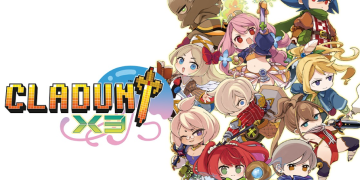The rise in popularity of roguelikes lately has brought a flood of new titles to the genre, achieving various degrees of success. Players generally recognize a standout roguelike by its satisfying progression, engaging gameplay moments, balanced with meaningful permanent upgrades, and that irresistible urge to attempt “just one more run.” However, the blend of these elements into something truly special remains a craft mastered only by the best in the genre. Passtech Games found this mix with their first action roguelike, Curse of the Dead Gods, and they are revisiting the genre with Ravenswatch. Leaving aside a few small balance issues, Ravenswatch emerges as one of the more impressive roguelikes of the year, breaking free from its initial PC-only availability.
Ravenswatch first appeared on PC through Early Access in April 2023, meeting largely positive feedback on Steam and eventually celebrating its full release in September this year. After refining it with numerous updates and new characters over an 18-month Early Access phase, Ravenswatch now debuts on PlayStation 5 and Xbox Series X/S. It’s presented in what is arguably its peak form, boasting a diverse and engaging cast of heroes that make every journey through the dreamlike world of Reverie an exciting one. Though it might not quite match up to giants like Hades (and the in-progress Hades 2), Ravenswatch offers a cooperative roguelike experience steeped in a mesmerizing fairy tale universe.
The true charm of the best roguelikes extends beyond gameplay to include in some backbone narrative, and Ravenswatch follows this pattern seamlessly. It takes place in Reverie, a dream world populated by fictional characters—a nod to Neil Gaiman’s Morpheus in Sandman—now under siege by monstrous “Nightmares” from Lovecraftian lore. These nefarious creatures aim to warp Reverie into their twisted domain, prompting the powers-that-be to call upon the legendary Ravenswatch heroes. This diverse group, drawn from stories and legends, stands as Reverie’s final hope against its potential ruin.
This storyline provides Passtech Games the perfect canvas to unleash creativity by crafting unique playable heroes and their abilities—and they certainly do not hold back. Players begin with four diverse heroes: Scarlet, merging aspects of Little Red Riding Hood with the Big Bad Wolf; Beowulf; the Snow Queen; and the Pied Piper, each bringing distinct combat styles. With different rhythms and strategies required to master their abilities, reminiscent of Diablo’s style, players can look forward to unlocking five more heroes over time. Earning new heroes is generally straightforward, usually through completing the first stage with another character. Experimenting with each hero’s abilities keeps gameplay fresh, as even those less fitting to a player’s style reveal their advantages.
Regardless of hero choice, players have the same set of core abilities. Alongside standard attacks, each hero boasts a Defense move, a Special, a Power, and a Trait. These can be enhanced through level-ups or purchases with Dream Shards from The Sandman, Ravenswatch’s currency system. Notably, unlike the heroes in Curse of the Dead Gods, characters retain these enhancements throughout their run, granting players an impressive power advantage by the time they face end-game bosses.
In Ravenswatch, defeating enemies and enhancing heroes are central, but each hero’s unique capabilities add significant replay value. Players will naturally favor certain characters, with standouts like Scarlet, who transforms into the Big Bad Wolf during the game’s Day/Night cycle, changing her abilities completely, or Sun Wukong, who toggles between boosting defense or attack. These dynamics ensure a run feels fresh each time, offering lots of reasons for players to revisit, try solo or cooperative modes, and explore different hero synergies.
Ravenswatch thrives on exciting gameplay choices, which can be crucial since the game faces challenges with balance and difficulty. Roguelikes are designed to be tough, requiring repeated attempts to gradually improve characters. However, Ravenswatch’s cooperative mode disturbs its balance, largely due to the shared pool of six Raven Feathers that enable players to resurrect, integrating this mechanic from co-op into solo play. This resurrection ability inadvertently encourages sturdier enemies to counterbalance this player advantage. Yet, co-op struggles with balancing further, as enemy numbers and health significantly increase, repeating solo play’s problems in a team setting.
Issues become more pronounced when facing boss battles at the end of stages. Solo runs can unravel quickly due to a botched boss fight, whether from unlucky variables or simple mistakes. Fortunately, unlocking talents and upgrades contributes to a rewarding progression system that increases survivability overall, although it does sometimes feel incremental.
Featuring nine heroes, each with extensive unlockable talents and more than 50 unique Magical Objects—some offering major boosts—Ravenswatch is one of the most replayable roguelikes available. Its combat diversity shines, ensuring it captivates players’ interest.
In my 25 hours with Ravenswatch on the PlayStation 5, I unlocked every hero and reached Rank 4 with each, though I have yet to conquer the final boss. Numerous Magical Objects and talents remain undiscovered, hinting at endless hours of additional content to explore, showcasing Ravenswatch’s impressive replayability.
Though it lacks the story depth seen in other titles like Hades, Ravenswatch’s vibrant combat system steals the show, echoing Passtech’s previous successes. The stunning cel-shaded visuals and smooth animations complement this experience, solidifying Ravenswatch as an engaging roguelike that might still need fine-tuning but easily stands out in today’s competitive market.







![[Rewrite] “Cat from Hell: PlayStation 5 Cat Simulator Review” [Rewrite] “Cat from Hell: PlayStation 5 Cat Simulator Review”](https://www.intergamerz.com/wp-content/uploads/2025/07/Rewrite-Cat-from-Hell-PlayStation-5-Cat-Simulator-Review-360x180.jpg)




































![[Rewrite] “Cat from Hell: PlayStation 5 Cat Simulator Review” [Rewrite] “Cat from Hell: PlayStation 5 Cat Simulator Review”](https://www.intergamerz.com/wp-content/uploads/2025/07/Rewrite-Cat-from-Hell-PlayStation-5-Cat-Simulator-Review-120x86.jpg)


